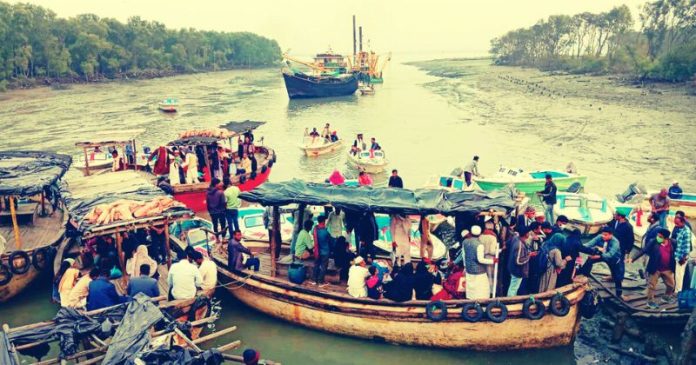The 400,000 residents of the island upazila of Maheshkhali are victims of relentless suffering. They must cross the sea to reach Cox’s Bazar district headquarters for medical treatment, court proceedings, district administration services, and most other government and non-government services. Over the past 15 years, a large number of residents have also had to regularly travel to Cox’s Bazar to collect compensation for land acquired under various development projects and to deal with related legal matters. However, the ferry ghat has become a nightmare for these commuters.
Long waits at the jetty for boats, risky boarding procedures, obstacles in transporting patients, a dilapidated jetty, a navigational crisis, misbehavior by ghat authorities and boat operators, suffering during storms and rain, and harassment by rickshaw pullers at the jetty are all constant sources of distress for the island’s residents.
According to locals, the Maheshkhali jetty, built during the Ershad regime in 1988 with a length of 500 meters and a width of 3.3 meters, was extended by another 100 meters in 2000 due to river siltation. However, continued siltation has created obstacles for boat movement during low tide. For the past 25 years, passengers have had to wade through mud during low tide. Although the area has been dredged two or three times in the last five years, it fills up again within a single season.
Field reports indicate that although the canal adjacent to the Maheshkhali jetty was dredged last season, it has filled up again with silt from the monsoon rains. This has resulted in a severe navigational crisis for the past five months. Speedboats and other passenger vessels are unable to dock at the ghat during low tide. Passengers are forced to disembark in the main river and take smaller dinghy boats to shore at great risk. During full low tide in the dry season, even these dinghy boats cannot operate, forcing people to wade through knee-deep or even deeper mud to reach the shore. Due to the navigational crisis, the No. 6 ghat has become unusable, forcing vessels to dock at the Nunia Chora BIWTA ghat instead. Similarly, the Adinath jetty has also become unfit for passenger transport due to siltation and dilapidation. As a result, patients, women, children, and the elderly face immense hardship.
Despite numerous movements and protests to alleviate this suffering, no effective measures have been taken by the administration. People from various strata of Maheshkhali have made written and other forms of complaints to the upazila and district administrations but to no avail.
S.M. Rubel, a resident of Maheshkhali, said, “There is no end to the suffering on this waterway, including the siltation of the jetty. Our patience has worn thin long ago. We have repeatedly drawn the administration’s attention, but nothing substantial has been done.”
In this regard, Maheshkhali Upazila Nirbahi Officer (UNO) Md. Hedayet Ullah stated that in early 2023, the Local Government Engineering Department (LGED), with funding from the World Bank, undertook the initiative to build a new jetty in Maheshkhali. Construction of the new jetty, located beside the current one, is 50 percent complete, and he expressed hope that the remaining work will be finished on schedule. The completion of the new jetty is expected to alleviate the suffering of the island’s residents during their sea travels. He further added that efforts are underway to address the current navigational crisis, and excavation work is being carried out at the silted-up jetty to ease the difficulties faced by passengers.
However, until the new jetty is completed, the suffering of Maheshkhali’s 400,000 residents will continue. The islanders’ only hope is for the administration to take swift and effective action to address this long-standing problem.



